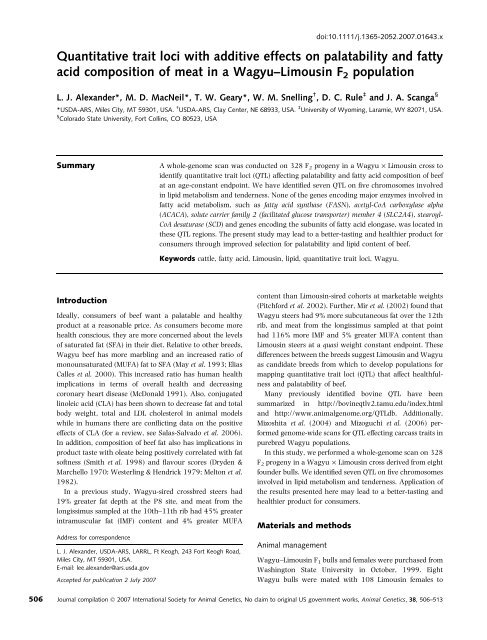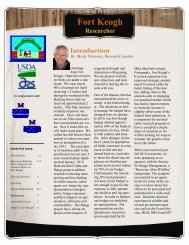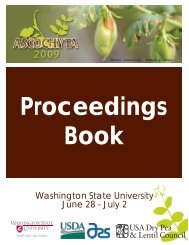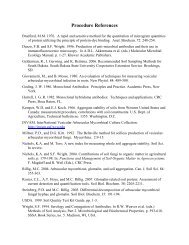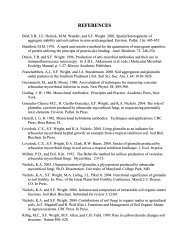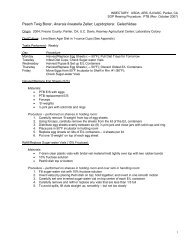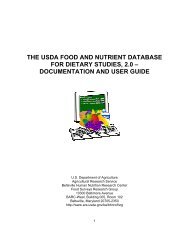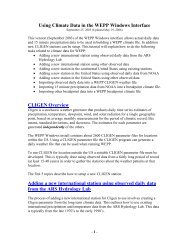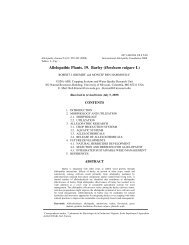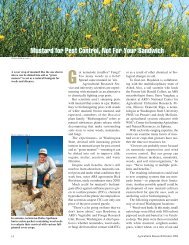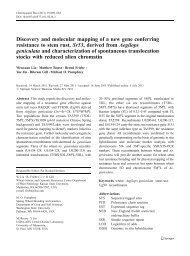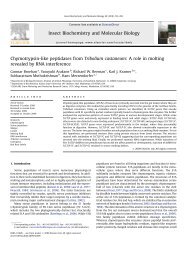Quantitative trait loci with additive effects on palatability - Agricultural ...
Quantitative trait loci with additive effects on palatability - Agricultural ...
Quantitative trait loci with additive effects on palatability - Agricultural ...
You also want an ePaper? Increase the reach of your titles
YUMPU automatically turns print PDFs into web optimized ePapers that Google loves.
506<br />
doi:10.1111/j.1365-2052.2007.01643.x<br />
<str<strong>on</strong>g>Quantitative</str<strong>on</strong>g> <str<strong>on</strong>g>trait</str<strong>on</strong>g> <str<strong>on</strong>g>loci</str<strong>on</strong>g> <str<strong>on</strong>g>with</str<strong>on</strong>g> <str<strong>on</strong>g>additive</str<strong>on</strong>g> <str<strong>on</strong>g>effects</str<strong>on</strong>g> <strong>on</strong> <strong>palatability</strong> and fatty<br />
acid compositi<strong>on</strong> of meat in a Wagyu–Limousin F 2 populati<strong>on</strong><br />
L. J. Alexander*, M. D. MacNeil*, T. W. Geary*, W. M. Snelling † , D. C. Rule ‡ and J. A. Scanga §<br />
*USDA-ARS, Miles City, MT 59301, USA. † USDA-ARS, Clay Center, NE 68933, USA. ‡ University of Wyoming, Laramie, WY 82071, USA.<br />
§ Colorado State University, Fort Collins, CO 80523, USA<br />
Summary A whole-genome scan was c<strong>on</strong>ducted <strong>on</strong> 328 F2 progeny in a Wagyu · Limousin cross to<br />
identify quantitative <str<strong>on</strong>g>trait</str<strong>on</strong>g> <str<strong>on</strong>g>loci</str<strong>on</strong>g> (QTL) affecting <strong>palatability</strong> and fatty acid compositi<strong>on</strong> of beef<br />
at an age-c<strong>on</strong>stant endpoint. We have identified seven QTL <strong>on</strong> five chromosomes involved<br />
in lipid metabolism and tenderness. N<strong>on</strong>e of the genes encoding major enzymes involved in<br />
fatty acid metabolism, such as fatty acid synthase (FASN), acetyl-CoA carboxylase alpha<br />
(ACACA), solute carrier family 2 (facilitated glucose transporter) member 4 (SLC2A4), stearoyl-<br />
CoA desaturase (SCD) and genes encoding the subunits of fatty acid el<strong>on</strong>gase, was located in<br />
these QTL regi<strong>on</strong>s. The present study may lead to a better-tasting and healthier product for<br />
c<strong>on</strong>sumers through improved selecti<strong>on</strong> for <strong>palatability</strong> and lipid c<strong>on</strong>tent of beef.<br />
Introducti<strong>on</strong><br />
Ideally, c<strong>on</strong>sumers of beef want a palatable and healthy<br />
product at a reas<strong>on</strong>able price. As c<strong>on</strong>sumers become more<br />
health c<strong>on</strong>scious, they are more c<strong>on</strong>cerned about the levels<br />
of saturated fat (SFA) in their diet. Relative to other breeds,<br />
Wagyu beef has more marbling and an increased ratio of<br />
m<strong>on</strong>ounsaturated (MUFA) fat to SFA (May et al. 1993; Elias<br />
Calles et al. 2000). This increased ratio has human health<br />
implicati<strong>on</strong>s in terms of overall health and decreasing<br />
cor<strong>on</strong>ary heart disease (McD<strong>on</strong>ald 1991). Also, c<strong>on</strong>jugated<br />
linoleic acid (CLA) has been shown to decrease fat and total<br />
body weight, total and LDL cholesterol in animal models<br />
while in humans there are c<strong>on</strong>flicting data <strong>on</strong> the positive<br />
<str<strong>on</strong>g>effects</str<strong>on</strong>g> of CLA (for a review, see Salas-Salvado et al. 2006).<br />
In additi<strong>on</strong>, compositi<strong>on</strong> of beef fat also has implicati<strong>on</strong>s in<br />
product taste <str<strong>on</strong>g>with</str<strong>on</strong>g> oleate being positively correlated <str<strong>on</strong>g>with</str<strong>on</strong>g> fat<br />
softness (Smith et al. 1998) and flavour scores (Dryden &<br />
Marchello 1970; Westerling & Hendrick 1979; Melt<strong>on</strong> et al.<br />
1982).<br />
In a previous study, Wagyu-sired crossbred steers had<br />
19% greater fat depth at the P8 site, and meat from the<br />
l<strong>on</strong>gissimus sampled at the 10th–11th rib had 45% greater<br />
intramuscular fat (IMF) c<strong>on</strong>tent and 4% greater MUFA<br />
Address for corresp<strong>on</strong>dence<br />
L. J. Alexander, USDA-ARS, LARRL, Ft Keogh, 243 Fort Keogh Road,<br />
Miles City, MT 59301, USA.<br />
E-mail: lee.alexander@ars.usda.gov<br />
Accepted for publicati<strong>on</strong> 2 July 2007<br />
Keywords cattle, fatty acid, Limousin, lipid, quantitative <str<strong>on</strong>g>trait</str<strong>on</strong>g> <str<strong>on</strong>g>loci</str<strong>on</strong>g>, Wagyu.<br />
c<strong>on</strong>tent than Limousin-sired cohorts at marketable weights<br />
(Pitchford et al. 2002). Further, Mir et al. (2002) found that<br />
Wagyu steers had 9% more subcutaneous fat over the 12th<br />
rib, and meat from the l<strong>on</strong>gissimus sampled at that point<br />
had 116% more IMF and 5% greater MUFA c<strong>on</strong>tent than<br />
Limousin steers at a quasi weight c<strong>on</strong>stant endpoint. These<br />
differences between the breeds suggest Limousin and Wagyu<br />
as candidate breeds from which to develop populati<strong>on</strong>s for<br />
mapping quantitative <str<strong>on</strong>g>trait</str<strong>on</strong>g> <str<strong>on</strong>g>loci</str<strong>on</strong>g> (QTL) that affect healthfulness<br />
and <strong>palatability</strong> of beef.<br />
Many previously identified bovine QTL have been<br />
summarized in http://bovineqtlv2.tamu.edu/index.html<br />
and http://www.animalgenome.org/QTLdb. Additi<strong>on</strong>ally,<br />
Mizoshita et al. (2004) and Mizoguchi et al. (2006) performed<br />
genome-wide scans for QTL effecting carcass <str<strong>on</strong>g>trait</str<strong>on</strong>g>s in<br />
purebred Wagyu populati<strong>on</strong>s.<br />
In this study, we performed a whole-genome scan <strong>on</strong> 328<br />
F2 progeny in a Wagyu · Limousin cross derived from eight<br />
founder bulls. We identified seven QTL <strong>on</strong> five chromosomes<br />
involved in lipid metabolism and tenderness. Applicati<strong>on</strong> of<br />
the results presented here may lead to a better-tasting and<br />
healthier product for c<strong>on</strong>sumers.<br />
Materials and methods<br />
Animal management<br />
Wagyu–Limousin F1 bulls and females were purchased from<br />
Washingt<strong>on</strong> State University in October, 1999. Eight<br />
Wagyu bulls were mated <str<strong>on</strong>g>with</str<strong>on</strong>g> 108 Limousin females to<br />
Journal compilati<strong>on</strong> Ó 2007 Internati<strong>on</strong>al Society for Animal Genetics, No claim to original US government works, Animal Genetics, 38, 506–513
produce 121 F1 females over a 3-year period, and three of<br />
the original eight bulls sired the six F1 bulls used. In this<br />
project, the F1 animals were inter se mated, except that<br />
mating of known relatives was avoided, to produce 328 F2<br />
progeny that were born in 2000–2003.<br />
Calves were reared by their dams, <str<strong>on</strong>g>with</str<strong>on</strong>g>out creep feed,<br />
until weaning at approximately 175 days of age (SD:<br />
14 days). Each year, before harvest, calves were randomly<br />
assigned separately by sex to a harvest date in groups of<br />
8–11 head per day. After weaning, the calves were managed<br />
in a two-phase system: a growing phase <str<strong>on</strong>g>with</str<strong>on</strong>g> diet<br />
compositi<strong>on</strong> of 50–54% DM, 14.4–15.6% CP and<br />
1.06–1.18 Mcal/kg net energy of gain (NEg), and a finishing<br />
phase <str<strong>on</strong>g>with</str<strong>on</strong>g> diet compositi<strong>on</strong> 68–70% DM, 11.6–13.4%<br />
CP and 1.26–1.31 Mcal/kg NEg. The finishing diet was fed<br />
a minimum of 113 days until the calves were harvested.<br />
Groups of calves were harvested at 2- to 3-week intervals.<br />
Thus, the final group harvested each year had been fed the<br />
finishing diet at least 210 days.<br />
Calves, 450–641 days of age (average 561 days), were<br />
transported to the abattoir the afterno<strong>on</strong> before harvest,<br />
held overnight <str<strong>on</strong>g>with</str<strong>on</strong>g> water and <str<strong>on</strong>g>with</str<strong>on</strong>g>out feed, and harvested<br />
the next morning using standard industry procedures.<br />
Hot carcass weight was measured immediately<br />
following harvest and prior to carcass rinsing/washing<br />
and chilling. Marbling score, fat thickness and percent<br />
kidney-pelvic-heart fat (KPH) were assessed by a trained<br />
evaluator after 48 h of chilling at 2 °C. Fat thickness was<br />
recorded at the 12th rib at a point three-fourths the<br />
width of the l<strong>on</strong>gissimus muscle from its chine b<strong>on</strong>e end.<br />
Marbling (4.00 ¼ slight 0 , 5.00 ¼ small 0 , 6.00 ¼ modest 0 ,<br />
7.00 ¼ moderate 0 , etc.) was determined at the interface<br />
of the 12th and 13th ribs and was evaluated by<br />
subjective comparis<strong>on</strong> of the amount of fat <str<strong>on</strong>g>with</str<strong>on</strong>g>in the<br />
l<strong>on</strong>gissimus muscle <str<strong>on</strong>g>with</str<strong>on</strong>g> photographic standards (Nati<strong>on</strong>al<br />
Livestock and Meat Board 1981). The amount of KPH<br />
was estimated and recorded as a percentage of carcass<br />
weight.<br />
After the carcasses were evaluated, wholesale 107-rib cut<br />
(North American Meat Processors Associati<strong>on</strong> 2002) was<br />
removed from each carcass, vacuum-packaged and aged for<br />
14 days at 2 °C. After ageing, a three-rib secti<strong>on</strong> and four<br />
2.54-cm-thick steaks were cut from the posterior end of the<br />
wholesale rib, then individually vacuum-packaged, frozen<br />
at )20 °C and held for further analyses.<br />
The frozen rib secti<strong>on</strong>s were transported to Colorado State<br />
University (CSU) for use in sensory and shear force evaluati<strong>on</strong>.<br />
Up<strong>on</strong> receipt at CSU, products were kept frozen<br />
()20 °C) prior to evaluati<strong>on</strong>. Frozen rib secti<strong>on</strong>s (ribs 9–11)<br />
were removed from their original packaging and three 2.54cm-thick<br />
steaks were cut from the distal end. Frozen steaks<br />
were vacuum-packaged and returned to frozen storage<br />
()20 °C). In preparati<strong>on</strong> for tenderness evaluati<strong>on</strong>, frozen<br />
steaks were removed from the freezer and tempered (2 °C)<br />
for 24–26 h prior to cooking.<br />
Warner–Bratzler shear force determinati<strong>on</strong><br />
Steaks were cooked <strong>on</strong> an electric c<strong>on</strong>veyor grill (model<br />
TGB-60; Magikitch’n) for 6 min and 35 s at a setting of<br />
176 °C to a target internal temperature of 70 °C. After<br />
cooking, each steak was allowed to equilibrate to room<br />
temperature (22 °C) and 6–10 cores (1.27 cm in diameter)<br />
were removed from each steak parallel to the muscle fiber<br />
orientati<strong>on</strong>. Each core was sheared <strong>on</strong>ce, perpendicular to<br />
the muscle fiber orientati<strong>on</strong>, <str<strong>on</strong>g>with</str<strong>on</strong>g> an Instr<strong>on</strong> testing<br />
machine fitted <str<strong>on</strong>g>with</str<strong>on</strong>g> a Warner–Bratzler shear head. Peak<br />
shear force measurements of each core were recorded and<br />
averaged to obtain a single shear force value (Warner–<br />
Bratzler shear force; WBSF) for each steak.<br />
Trained sensory panel<br />
Steaks were cooked as previously described and porti<strong>on</strong>ed<br />
into uniform pieces (1.3 · 1.3 · 1.9 cm) for sensory panel<br />
evaluati<strong>on</strong>. Sensory samples were served warm (approximately<br />
50 °C) to an eight-member panel. Panelists were<br />
selected and trained according to procedures outlined by<br />
American Meat Science Associati<strong>on</strong> (1995). Panelists<br />
scored each sample <strong>on</strong> an 8-point scale for initial juiciness,<br />
muscle fibre tenderness, c<strong>on</strong>nective tissue amount, overall<br />
tenderness and beef flavour intensity (8 ¼ extremely juicy,<br />
extremely tender, n<strong>on</strong>e, extremely tender, extremely beefy<br />
for these characteristics respectively; 1 ¼ extremely dry,<br />
extremely tough, abundant, extremely tough, extremely<br />
bland for these characteristics respectively).<br />
Fatty acid analysis<br />
QTL scan for fatty acid of beef 507<br />
Two steaks from each carcass were transported to University<br />
of Wyoming for the determinati<strong>on</strong> of fatty acid compositi<strong>on</strong><br />
as described by Rule et al. (2002). Briefly, the entire<br />
core of the l<strong>on</strong>gissimus dorsi was sampled (i.e. devoid of trim<br />
fat and extraneous muscles) by dicing the muscle into<br />
1.0-cm cubes while the muscle was semi-frozen and then<br />
weighed into pre-weighed, plastic cups <str<strong>on</strong>g>with</str<strong>on</strong>g> perforated lids.<br />
All samples were freeze-dried (Genesis 25 freeze dryer; The<br />
VirTis Co.) and then ground and homogenized using a<br />
home-style electric coffee grinder. Samples were packed into<br />
20-ml plastic vials and sealed to inhibit exposure to air, and<br />
then stored at )80 °C until analysed for fatty acids and<br />
cholesterol, which occurred <str<strong>on</strong>g>with</str<strong>on</strong>g>in 2 to 4 weeks of freezedrying.<br />
Approximately 150 mg of dried muscle was<br />
weighed, in duplicate, into 16 · 125-mm screw-capped<br />
tubes that c<strong>on</strong>tained 1.0 mg of tridecanoic acid as internal<br />
standard, and then subjected to direct sap<strong>on</strong>ificati<strong>on</strong> as<br />
described by Rule et al. (2002). Samples were reacted <str<strong>on</strong>g>with</str<strong>on</strong>g><br />
4.0 ml of 1.18 M KOH in ethanol at 90 °C al<strong>on</strong>g <str<strong>on</strong>g>with</str<strong>on</strong>g><br />
frequent vortex-mixing (two to three times per minute for<br />
3 s each time) until the sample was completely dissolved,<br />
except for insoluble collagen that appeared as a white<br />
Journal compilati<strong>on</strong> Ó 2007 Internati<strong>on</strong>al Society for Animal Genetics, No claim to original US government works, Animal Genetics, 38, 506–513
508<br />
Alexander et al.<br />
powder in suspensi<strong>on</strong> up<strong>on</strong> mixing. After about 45 min,<br />
tubes were cooled, 2.0 ml of water was added and cholesterol<br />
was extracted <str<strong>on</strong>g>with</str<strong>on</strong>g> 2.0 ml of hexane that c<strong>on</strong>tained<br />
0.1 mg/ml of stigmasterol as internal standard for<br />
the cholesterol assay; the hexane phase was transferred to<br />
gas liquid chromatography (GLC) vials and sealed. One<br />
millilitre of c<strong>on</strong>centrated HCl was added to the original<br />
tubes and fatty acids were extracted in 2.0 ml of hexane<br />
for fatty acid methyl ester (FAME) preparati<strong>on</strong>, which was<br />
carried out according to Rule et al. (2002) using methanolic<br />
HCl as a catalyst. Analysis of CLA is hampered by<br />
use of acid catalysts because of partial geometric isomerizati<strong>on</strong><br />
of cis-9, trans-11 CLA to trans-9, trans-11 CLA<br />
(Yamasake et al. 1999) and degradati<strong>on</strong> of CLA to allylic<br />
methoxy artifacts (Kramer et al. 1997). However, Murrieta<br />
et al. (2003) dem<strong>on</strong>strated that dietary treatment <str<strong>on</strong>g>effects</str<strong>on</strong>g><br />
<strong>on</strong> CLA in ovine muscle were maintained when acid catalysts<br />
were used for FAME preparati<strong>on</strong>, despite up to 20%<br />
loss of cis-9, trans-11 CLA. Preparati<strong>on</strong> of FAME from<br />
n<strong>on</strong>esterified free fatty acids (NEFA) requires the use of the<br />
acid catalyst because alkaline catalysts do not react <str<strong>on</strong>g>with</str<strong>on</strong>g><br />
NEFA to form FAMEs (Christie 1982). For the current<br />
study, freeze-dried muscle samples were chosen at random<br />
from approximately 5% of the samples for FAME preparati<strong>on</strong><br />
using methanolic KOH, which does not affect CLA<br />
proporti<strong>on</strong>s. We did not observe losses of CLA in the<br />
samples analysed (data not shown). Generally, we have<br />
observed either minimal or no loss of CLA in samples<br />
c<strong>on</strong>taining low c<strong>on</strong>centrati<strong>on</strong>s (about 0.5 mg per 100 mg<br />
of total fatty acids) of this fatty acid. Cholesterol c<strong>on</strong>centrati<strong>on</strong><br />
was determined using GLC as described by Rule<br />
et al. (1997), and fatty acids were analysed by GLC as<br />
described by Murrieta et al. (2003).<br />
Genotyping<br />
DNA was extracted from semen of sires of the F 1 bulls<br />
and from white blood cells of the F 1 bulls, F 1 females and<br />
F 2 calves using standard protocols (e.g. Ausubel et al.<br />
1994). Touchdown PCR was performed in MJ Research<br />
thermocyclers as described previously (MacNeil & Grosz<br />
2002). All genotypes were collected <strong>on</strong> a LiCor 4200<br />
DNA Analysis System. Genotypes were independently<br />
scored by two individuals. PCR was repeated for discrepancies<br />
that could not be resolved. Anomalous genotypes<br />
were detected using GENOPROB (Thallman et al. 2001a,b).<br />
Genetic linkage maps were c<strong>on</strong>structed using CRI-MAP<br />
(Green et al. 1990; http://compgen.rutgers.edu/multimap/<br />
crimap/). Initially, 156 markers covering the 29 bovine<br />
autosomes were chosen from http://www.marc.usda.gov/<br />
genome/cattle/cattle.html based <strong>on</strong> marker positi<strong>on</strong>, suitability<br />
for multiplex reacti<strong>on</strong>s, ease of scoring and number<br />
of alleles. Fine-mapping was performed by adding an<br />
additi<strong>on</strong>al 61 markers in areas of the genome exhibiting<br />
the presence of a QTL.<br />
Data analyses<br />
Quantities of the various fatty acids were summarized by<br />
calculating total amounts per 100 mg dry tissue of SFA<br />
MUFA, polyunsaturated fatty acids (PUFA) and three<br />
indexes of D 9 desaturase activity (R 1 ¼ 14:1 to 14:0; R 2 ¼<br />
16:1 to 16:0; R 3 ¼ 18:1 to 18:0). Amounts of CLA and<br />
cholesterol were analysed separately.<br />
QTL were identified by least squares regressi<strong>on</strong> analysis<br />
using the F2 analysis opti<strong>on</strong> of the QTL Express program<br />
(Seat<strong>on</strong> et al. 2002; http://qtl.cap.ed.ac.uk/) which generated<br />
an F-statistic profile at 1-cM intervals for each chromosome.<br />
For each chromosome, the effect of a single<br />
<str<strong>on</strong>g>additive</str<strong>on</strong>g> QTL was modelled <str<strong>on</strong>g>with</str<strong>on</strong>g> simultaneous adjustment<br />
for classificati<strong>on</strong> <str<strong>on</strong>g>effects</str<strong>on</strong>g> of year and sex, and the c<strong>on</strong>tinuous<br />
linear effect of age at harvest. Given the random<br />
assignment of animals to harvest dates and the statistical<br />
model, the data were adjusted to an age-c<strong>on</strong>stant endpoint.<br />
For newly identified QTL, the observed significance<br />
level was adjusted to a genome-wide basis following the<br />
procedure described by Cheverud (2001). The observed<br />
significance level was used to c<strong>on</strong>firm previously identified<br />
QTL.<br />
To identify positi<strong>on</strong>al candidate genes underlying QTL,<br />
bacterial artificial chromosome (BAC) c<strong>on</strong>tigs corresp<strong>on</strong>ding<br />
to QTL were identified from the bovine composite map (W. M.<br />
Snelling et al. in preparati<strong>on</strong>; http://genomes.tamu.edu/<br />
cgi-bin/gbrowse/bosmap2/). Syntenic regi<strong>on</strong>s defined by the<br />
bovine BAC-human comparative map were determined, and<br />
a list of Ensembl genes was extracted using BioMart (http://<br />
www.ensembl.org/Homo_sapiens/index.html) and summarized<br />
<str<strong>on</strong>g>with</str<strong>on</strong>g> the Gene Ontology Tree Machine (Zhang et al.<br />
2004; http://bioinfo.vanderbilt.edu/gotm/).<br />
Results and discussi<strong>on</strong><br />
Initially, 157 microsatellite markers that covered the 29<br />
autosomes were chosen from the USMARC genetic linkage<br />
map (http://www.marc.usda.gov/genome/cattle/cattle.html)<br />
(Table S1). An additi<strong>on</strong>al 61 markers were added in regi<strong>on</strong>s<br />
that exhibited potential QTL. Most of the maps generated in<br />
this study were in good agreement <str<strong>on</strong>g>with</str<strong>on</strong>g> the USMARC<br />
bovine linkage maps, <str<strong>on</strong>g>with</str<strong>on</strong>g> the excepti<strong>on</strong> that some<br />
chromosomes were inflated in length. Chromosomes whose<br />
length were more than 15% greater than indicated by the<br />
USMARC map were BTA2 (26%), 9 (16%), 12 (19%), 13<br />
(26%), 14 (22%), 18 (23%) 20 (21%) and 27 (20%)<br />
(Table S1).<br />
Mean values and standard deviati<strong>on</strong>s for the phenotypes<br />
evaluated in this study are shown in Table 1. Six new QTL<br />
involved in lipid metabolism and depositi<strong>on</strong> were identified<br />
<strong>on</strong> four chromosomes during this study and are summarized<br />
in Table 2.<br />
A QTL <str<strong>on</strong>g>with</str<strong>on</strong>g> multi-faceted significant <str<strong>on</strong>g>effects</str<strong>on</strong>g> <strong>on</strong> CLA [F ¼<br />
12.01, P ¼ 0.013 (genome-wide significance)], marbling<br />
Journal compilati<strong>on</strong> Ó 2007 Internati<strong>on</strong>al Society for Animal Genetics, No claim to original US government works, Animal Genetics, 38, 506–513
Table 1 Means and standard deviati<strong>on</strong>s of phenotypes examined in<br />
this study.<br />
Phenotype X SD<br />
Cholesterol (mg/100 g dry tissue) 218 21<br />
CLA (mg/100 g dry tissue) 43.3 15.8<br />
Subcutaneous fat depth (mm) 0.39 0.16<br />
KPH (%) 2.65 0.35<br />
Marbling 6.07 1.2<br />
MUFA (mg/100 g dry tissue) 10 484 3077<br />
SFA (mg/100 g dry tissue) 9033 2607<br />
PUFA (mg/100 g dry tissue) 883 130<br />
R1 – ratio of C14:1 to C14:0 0.276 0.073<br />
R2 – ratio of C16:1 to C16:0 0.146 0.018<br />
R3 – ratio of C18:1 to C18:0 3.73 0.47<br />
Warner–Bratzler shear force (WBSF), kg 3.94 0.69<br />
C<strong>on</strong>nective tissue 7.26 0.36<br />
Myo-fibral tenderness 5.89 0.73<br />
Overall tenderness 5.88 0.72<br />
Flavour 5.61 0.37<br />
Juiciness 5.93 0.46<br />
CLA, c<strong>on</strong>jugated linoleic acid; KPH, kidney–pelvic–heart fat; MUFA,<br />
m<strong>on</strong>ounsaturated fatty acid; SFA, saturated fatty acid; PUFA, polyunsaturated<br />
fatty acid.<br />
(F ¼ 11.76, P ¼ 0.015), MUFA (F ¼ 21.37, P ¼<br />
0.00012), SFA (F ¼ 12.52, P ¼ 0.01), R 2 (F ¼ 19.44,<br />
P ¼ 0.00032), R 3 (F ¼ 25.18, P ¼ 0.00002) and a<br />
suggestive effect <strong>on</strong> flavour (F ¼ 7.91, P ¼ 0.11) were<br />
observed towards the centromere of BTA2 (Fig. 1). Informati<strong>on</strong><br />
c<strong>on</strong>tent of individual markers in this regi<strong>on</strong> ranged<br />
from 0.24 to 0.63. These QTL <str<strong>on</strong>g>effects</str<strong>on</strong>g> are seemingly c<strong>on</strong>sistent<br />
<str<strong>on</strong>g>with</str<strong>on</strong>g> a unified biological model supportive of a gene<br />
or genes segregating between Wagyu and Limousin in this<br />
regi<strong>on</strong> that c<strong>on</strong>fer greater lipid c<strong>on</strong>tent, greater stearoyl-<br />
CoA desaturase-like activity and a more desirably flavoured<br />
steak <strong>on</strong> the Wagyu breed. Flavour has been positively<br />
correlated <str<strong>on</strong>g>with</str<strong>on</strong>g> the MUFA oleate (Dryden & Marchello<br />
1970; Westerling & Hendrick 1979; Melt<strong>on</strong> et al. 1982)<br />
and the subjectivity and categorical scale of its measurement<br />
may compromise the ability to detect QTL <str<strong>on</strong>g>effects</str<strong>on</strong>g>.<br />
Casas et al. (1998) and MacNeil & Grosz (2002) identified<br />
QTL <str<strong>on</strong>g>with</str<strong>on</strong>g> <str<strong>on</strong>g>effects</str<strong>on</strong>g> <strong>on</strong> KPH fat in this regi<strong>on</strong>. Also, Casas et al.<br />
(1998) previously reported a co-located QTL for marbling<br />
score. Taken together, these results str<strong>on</strong>gly suggest the<br />
centromeric regi<strong>on</strong> of BTA2 as a candidate for further<br />
investigati<strong>on</strong>. The QTL regi<strong>on</strong> corresp<strong>on</strong>ds to c<strong>on</strong>tig<br />
ctg2005 <strong>on</strong> the internati<strong>on</strong>al bovine BAC map (http://<br />
www.bcgsc.ca/downloads/bovinemap.tar.gz), which is<br />
syntenic <str<strong>on</strong>g>with</str<strong>on</strong>g> the 168-to-191-Mb regi<strong>on</strong> of HSA2, which<br />
c<strong>on</strong>tains nearly 200 genes.<br />
A QTL <str<strong>on</strong>g>with</str<strong>on</strong>g> an effect <strong>on</strong> MUFA (125 cM, F ¼ 10.76,<br />
P ¼ 0.025) was observed <strong>on</strong> BTA7 (Fig. 2). Informati<strong>on</strong><br />
c<strong>on</strong>tent of individual markers in this regi<strong>on</strong> ranged from<br />
0.02 to 0.60. This QTL regi<strong>on</strong> also affected R2, R3, SFA and<br />
QTL scan for fatty acid of beef 509<br />
CLA, although these <str<strong>on</strong>g>trait</str<strong>on</strong>g>s <strong>on</strong>ly had genome-wide significance<br />
levels of P ¼ 0.057, 0.076, 0.065 and 0.092<br />
respectively. A sec<strong>on</strong>d suggestive QTL affecting KPH<br />
(40 cM, F ¼ 8.16, P ¼ 0.096) was observed at 40 cM <strong>on</strong><br />
our BTA7 map, and covers porti<strong>on</strong>s of the bovine genome<br />
syntenic <str<strong>on</strong>g>with</str<strong>on</strong>g> HSA5 and HSA19. Informati<strong>on</strong> c<strong>on</strong>tent of<br />
individual markers in this regi<strong>on</strong> ranged from 0.29 to 0.56.<br />
The 2-to-19-Mb regi<strong>on</strong> of HSA19, corresp<strong>on</strong>ding to the<br />
KPH fat QTL, c<strong>on</strong>tains 21 genes <str<strong>on</strong>g>with</str<strong>on</strong>g> lipid-related functi<strong>on</strong>.<br />
No lipid-related genes are in the 128-to-131-Mb regi<strong>on</strong> of<br />
HSA5 under the KPH QTL, although the 89-to-110-Mb<br />
regi<strong>on</strong> of HSA5 corresp<strong>on</strong>ding to the R2, R3 and MUFA QTL<br />
c<strong>on</strong>tains three genes related to lipid and phospholipid<br />
binding: RGM domain family member B (RGMB), multiple C2<br />
domains transmembrane protein (MCTP1) and ephrin-A5<br />
(EFNA5). To our knowledge, neither of these QTL has been<br />
reported before. However, Casas et al. (2003) reported a<br />
QTL <str<strong>on</strong>g>with</str<strong>on</strong>g> <str<strong>on</strong>g>effects</str<strong>on</strong>g> <strong>on</strong> fat thickness in the interval between 44<br />
and 71 cM <strong>on</strong> BTA7. While not as compelling as the regi<strong>on</strong><br />
<strong>on</strong> BTA2, these results suggest that BTA7 merits further<br />
investigati<strong>on</strong> for genes affecting lipid depositi<strong>on</strong> and<br />
metabolism. BTA12 also had a QTL regi<strong>on</strong> near the centromere<br />
that slightly affected SFA and MUFA (BTA12, F ¼<br />
9.43, P ¼ 0.052 and F ¼ 7.66, P ¼ 0.128 respectively)<br />
and R2 (BTA28, F ¼ 9.29, P ¼ 0.11). The substituti<strong>on</strong> of a<br />
Wagyu allele replacing a Limousin allele (Table 2) promoted<br />
more MUFA and SFA <strong>on</strong> BTA2 where <strong>on</strong> BTA7 and<br />
12 the Wagyu alleles repressed MUFA and SFA.<br />
The centromeric regi<strong>on</strong> of BTA5 had a QTL influencing<br />
myofibril (F ¼ 12.66, P ¼ 0.008) and overall tenderness<br />
(F ¼ 10.17, P ¼ 0.030). Informati<strong>on</strong> c<strong>on</strong>tent of individual<br />
markers in this regi<strong>on</strong> ranged from 0.38 to 0.83. Casas<br />
et al. (2000) also found a QTL for tenderness <strong>on</strong> BTA5;<br />
however, their locati<strong>on</strong> was at 65 cM. Other suggestive<br />
QTL affecting subcutaneous fat thickness (BTA1, F ¼ 9.7,<br />
P ¼ 0.051) and WBSF (BTA10, F ¼ 7.90, P ¼ 0.117)<br />
were observed in this study. Casas et al. (2003) also found<br />
a QTL affecting fat thickness in the same area of BTA1 as<br />
reported here. Because of the reputati<strong>on</strong> of the <strong>palatability</strong><br />
of Wagyu meat, it was somewhat surprising that no<br />
significant differences were detected by the sensory panel<br />
for flavour and juiciness. This lack of difference has been<br />
reported before between Angus and crossbred (3/4 and 7/8)<br />
Wagyu steers (May et al. 1993). However, Elias Calles<br />
et al. (2000) found in F 1 crosses a positive correlati<strong>on</strong><br />
between marbling and flavour, tenderness and juiciness<br />
using ÔOldÕ and ÔNewÕ Wagyu bulls mated <str<strong>on</strong>g>with</str<strong>on</strong>g> either<br />
Angus or Angus · Hereford · Simmental crosses. Other<br />
phenotypes for which QTL were not detected are also listed<br />
in Table 2.<br />
Mizoshita et al. (2004) and Mizoguchi et al. (2006)<br />
previously reported genome scans using purebred<br />
Wagyu germplasm and found QTL for marbling (BTA4, 6<br />
and 21) and subcutaneous fat depth (BTA13). Data<br />
from the present study c<strong>on</strong>firmed the above centrally<br />
Journal compilati<strong>on</strong> Ó 2007 Internati<strong>on</strong>al Society for Animal Genetics, No claim to original US government works, Animal Genetics, 38, 506–513
510<br />
Alexander et al.<br />
Table 2 Locati<strong>on</strong> of QTL affecting lipid depositi<strong>on</strong>, profile and meat characteristic <str<strong>on</strong>g>trait</str<strong>on</strong>g>s in a Wagyu · Limousin cattle populati<strong>on</strong>.<br />
Significance 4<br />
Flanking marker, positi<strong>on</strong> (cM)<br />
Additive effect ± S.E 5<br />
Nominal Genome-wide<br />
End<br />
CI F-statistic<br />
Start<br />
CI<br />
95%<br />
CI 3<br />
Positi<strong>on</strong><br />
cM<br />
BTA 2<br />
Trait 1<br />
Fat_d 1 58 46 35 81 9.7 0.002 0.051 )0.053 ± 0.017 BMS4030, 48.7; DIK2121, 62.4<br />
CLA 2 2 46 0 25 12.01 0.001 0.013 5.265 ± 1.519 TGLA44, 0.00; DIK4469, 3.50; ILSTS026, 9.7<br />
Flavour 2 0 70 0 35 7.91 0.005 0.11* 0.096 ± 0.035 TGLA44, 0.00; DIK4469, 3.50<br />
KPH 2 25 55 0 53 9.33 0.002 0.054 0.105 ± 0.034 DIK1172, 21.7; CSFM050, 24.90; TEXAN-2, 35.40<br />
Marbling 2 3 49 0 28 11.76 0.001 0.015 0.400 ± 0.117 DIK4469, 3.50; ILSTS026, 9.7<br />
MUFA 2 5 24 0 17 21.37 5.66E-06 1.26E-04 1374.7 ± 297.3 TGLA44, 0.00; DIK4469, 3.50; ILSTS026, 9.7<br />
SFA 2 10 40 0 30 12.52 0.000 0.010 919.8 ± 260.0 DIK4469, 3.50; ILSTS026, 9.7<br />
R2 2 3 28 0 17 19.44 1.45E-05 3.24E-04 0.778 ± 0.176 DIK4469, 3.50; ILSTS026, 9.70; TGLA431, 12.7<br />
R3 2 4 21 0 15 25.18 9.03E-07 2.01E-05 22.445 ± 4.473 TGLA44, 0.00; DIK4469, 3.50; ILSTS026, 9.7<br />
Myo-fibral tenderness 5 0 44 0 22 12.66 0.0004 0.008 )0.246 ± 0.069 BMS1095, 0;BM6026, 10.4<br />
Overall tenderness 5 0 58 0 29 10.17 0.002 0.030 )0.216 ± 0.068 BMS1095, 0;BM6026, 10.4<br />
CLA 7 131 47 108 end 8.24 0.004 0.092 )5.195 ± 1.810 CST, 122; BMS1979, 133.4<br />
KPH 7 40 77 2 79 8.16 0.005 0.096 )0.090 ± 0.031 BMS713, 21.1; BM6105, 40.3; TGLA303, 42.2<br />
MUFA 7 125 48 101 end 10.76 0.001 0.025 )1095.8 ± 334.0 CST, 122; BMS1979, 133.4<br />
SFA 7 125 40 105 end 8.93 0.003 0.065 )848.5 ± 283.9 CST, 122; BMS1979, 133.4<br />
R2 7 110 55 83 end 9.17 0.003 0.057 )0.547 ± 0.181 BM9065, 99.7; DIK4838, 110.5; CST, 122<br />
R3 7 108 62 77 end 8.62 0.004 0.076 )13.4 ± 4.58 BM9065, 99.7; DIK4838, 110.5; CST, 122<br />
CLA 7 131 47 108 end 8.24 0.004 0.092 )5.195 ± 1.810 CST, 122; BMS1979, 133.4<br />
WBSF 10 95 21 85 end 7.9 0.005 0.117* )0.316 ± 0.112 BMS2641, 79.2; BL1134, 110.9<br />
MUFA 12 0 66 0 33 7.66 0.006 0.128* )766.7 ± 277.0 BMS410, 0;DIK2916, 7.90<br />
SFA 12 0 82 0 41 9.43 0.002 0.052 )718.7 ± 234.0 BMS410, 0.00; DIK2916, 7.90<br />
R2 28 50 11 45 end 9.29 0.003 0.11* 1.247 ± 0.409 BM7246, 33.4; MB023, 50.5 (end)<br />
Cholesterol ND<br />
C<strong>on</strong>nective tissue ND<br />
Juiciness ND<br />
PUFA ND<br />
R1 ND<br />
Journal compilati<strong>on</strong> Ó 2007 Internati<strong>on</strong>al Society for Animal Genetics, No claim to original US government works, Animal Genetics, 38, 506–513<br />
1 Fat_d, subcutaneous fat depth; CLA, c<strong>on</strong>jugated linoleic acid; KPH, kidney–pelvic–heart fat; MUFA, amount of m<strong>on</strong>ounsaturated fat; R1, ratio of C14:1 to C14:0; R 2, ratio of C16:1 to C16:0; R 3, ratio of<br />
C18:1 to C18:0; SFA, amount of saturated fat; WBSF, Warner–Bratzler shear force.<br />
2<br />
ND, no suggestive or significant associati<strong>on</strong> detected.<br />
3 C<strong>on</strong>fidence interval, calculated by the method of Darvasi & Soller (1997).<br />
4<br />
Significant
Figure 1 BTA2 F-statistic profiles for flavour (FLV), ratio of C16:1 to<br />
C16:0 fatty acids (R2), ratio of C18:1 to C18:0 fatty acids (R3),<br />
c<strong>on</strong>jugated linoleic acid (CLA), per cent kidney–pelvic–heart fat (KPH),<br />
marbling score (MRB), saturated fatty acids (SFA), and m<strong>on</strong>ounsaturated<br />
fatty acids (MUFA). From centromere to telomere, markers were<br />
TGLA44, DIK4469, ILSTS026, TGLA431, DIK1172, CSFM050, TEXAN-<br />
2, TGLA377, RM356, ILSTS050, BMS1866, BMS2267 and BM2113<br />
(shown as triangles). The genome-wide significance threshold of 9.46 is<br />
shown as a horiz<strong>on</strong>tal line.<br />
Figure 2 BTA7 F-statistic profiles for flavour (FLV), ratio of C16:1 to<br />
C16:0 fatty acids (R2), ratio of C18:1 to C18:0 fatty acids (R3),<br />
c<strong>on</strong>jugated linoleic acid (CLA), per cent kidney–pelvic–heart fat (KPH),<br />
marbling score (MRB), saturated fatty acids (SFA), and m<strong>on</strong>ounsaturated<br />
fatty acids (MUFA). From centromere to telomere, markers were<br />
BM7160, DIK2870, BL1067, BMS713, BM6105, TGLA303, DIK2819,<br />
TGLA164, UWCA20, BMS2258, BM9065, DIK4838, CST, BMS1979<br />
and BMS1247 (shown as triangles). The genome-wide significance<br />
threshold of 9.40 is shown as a horiz<strong>on</strong>tal line.<br />
located QTL for marbling <strong>on</strong> BTA4 (max F ¼ 5.32 at 66<br />
cM, Pnominal significance (ns) ¼ 0.02). However, these data do<br />
not c<strong>on</strong>firm the other QTL for marbling and subcutaneous<br />
fat depth reported by Mizoshita et al. (2004) and<br />
Mizoguchi et al. (2006). The lack of corresp<strong>on</strong>dence of<br />
QTL between the previously reported projects and the<br />
present study may result from numerous differences<br />
between our experiments. Mizoshita et al. (2004) and<br />
Mizoguchi et al. (2006) searched for QTL that segregated<br />
QTL scan for fatty acid of beef 511<br />
<str<strong>on</strong>g>with</str<strong>on</strong>g>in Wagyu, whereas we searched for QTL that segregated<br />
between Wagyu and Limousin. Substantive differences<br />
also exist between the studies in feeding strategies;<br />
in the present study, cattle were harvested at younger<br />
ages (15–21 m<strong>on</strong>ths) than in the studies of Mizoshita<br />
et al. (2004); 30 m<strong>on</strong>ths) and Mizoguchi et al. (2006;<br />
29–32 m<strong>on</strong>ths).<br />
To evaluate genes encoding enzymes involved in fatty acid<br />
metabolism as candidates for QTL observed here, we examined<br />
their genomic locati<strong>on</strong>s. Fatty acid synthase (FASN; Roy<br />
et al. 2001) and acetyl-CoA carboxylase alpha (ACACA; Mao<br />
et al. 2001), which are involved in de novo synthesis of fatty<br />
acids, were located <strong>on</strong> BTA19 while acetyl-CoA carboxylase<br />
beta (ACACB) was placed <strong>on</strong> BTA16 and BTA17 (http://<br />
www.ncbi.nlm.nih.gov/entrez/query.fcgi?db¼genomeprj&<br />
cmd¼Retrieve&dopt¼Overview&list_uids¼10708). Solute<br />
carrier family 2 (facilitated glucose transporter), member 4<br />
(SLC2A4), previously known as GLUT4, facilitates uptake of<br />
glucose that may be used in de novo fatty acid synthesis by<br />
muscle and adipose tissues and was also present <strong>on</strong> BTA19<br />
(http://www.ncbi.nlm.nih.gov/mapview/map_search.cgi?<br />
taxid¼9913&query¼GLUT4&qchr¼&advsrch¼off).<br />
An obvious candidate gene for several of the observed<br />
differences in MUFA:SFA is bovine stearoyl-CoA desaturase<br />
(SCD). Campbell et al. (2001) mapped SCD (AF188710) to<br />
BTA26q21. A cDNA sequence has been isolated for bovine<br />
stearoyl-CoA desaturase 5 (SCD5) (BC112711). Its genomic<br />
locati<strong>on</strong> was not certain as c<strong>on</strong>flicting positi<strong>on</strong>s for this gene<br />
are <strong>on</strong> BTA6 and BTA11.<br />
Thus, the locati<strong>on</strong>s of FASN, ACACA, ACACB, SLC2A4,<br />
SCD and SCD5 exclude them as candidates for the observati<strong>on</strong>s<br />
reported here. Another candidate enzyme may be<br />
fatty acid el<strong>on</strong>gase. Subunits of this enzyme were identified<br />
using the Kyoto Encyclopedia of Genes and Genomes (KEGG;<br />
http://www.genome.jp/kegg/). N<strong>on</strong>e of the genes encoding<br />
the subunits was near the QTL reported here; however, <strong>on</strong>e<br />
subunit, hydroxysteroid (17-beta) dehydrogenase 10<br />
(HSD17B10), previously known as HADH2, has not been<br />
placed in the bovine genome sequence.<br />
Previous genome scans using purebred Wagyu found QTL<br />
for marbling and subcutaneous fat depth <strong>on</strong> BTA4, 6 and<br />
21 (Mizoshita et al. 2004; Mizoguchi et al. 2006). In additi<strong>on</strong>,<br />
some candidate genes for marbling and subcutaneous<br />
fat depth, leptin (LEP) <strong>on</strong> BTA4; thyroglobulin (TG), diacylglycerol<br />
O-acyltransferase (DGAT1, Winter et al. 2002; De<br />
et al. 2004) and fatty acid binding protein (FABP4, Michal<br />
et al. 2006) <strong>on</strong> BTA14; growth horm<strong>on</strong>e (GH) <strong>on</strong> BTA19 and<br />
mitoch<strong>on</strong>drial transcripti<strong>on</strong> factor A (TFAM, Jiang et al. 2005)<br />
<strong>on</strong> BTA28 have been explored in this Wagyu · Limousin<br />
populati<strong>on</strong>. These present data cannot exclude the <str<strong>on</strong>g>effects</str<strong>on</strong>g> of<br />
LEP <strong>on</strong> BTA4 (F ¼ 5.32, Pns ¼ 0.02), FABP4 <strong>on</strong> BTA14<br />
(F ¼ 3.98, Pns ¼ 0.05) or GH <strong>on</strong> BTA19 (F ¼ 3.29, Pns ¼<br />
0.07) <strong>on</strong> marbling. The GH locus (BTA19) has also been<br />
reported to affect fatty acid compositi<strong>on</strong> of beef (Taylor et al.<br />
1998).<br />
Journal compilati<strong>on</strong> Ó 2007 Internati<strong>on</strong>al Society for Animal Genetics, No claim to original US government works, Animal Genetics, 38, 506–513
512<br />
Alexander et al.<br />
In summary, we have identified seven new QTL regi<strong>on</strong>s<br />
<strong>on</strong> five chromosomes that influence tenderness, fatty acid<br />
depositi<strong>on</strong> and profiles and meat quality in an F2 Wagyu<br />
· Limousin populati<strong>on</strong>. Further investigati<strong>on</strong> of these<br />
QTL will promote our understanding of lipid metabolism<br />
and fat depositi<strong>on</strong> in cattle. As the c<strong>on</strong>sumer becomes more<br />
health c<strong>on</strong>scious they have increased c<strong>on</strong>cerns about the<br />
levels of SFA in their diet. Therefore, CLA and the ratio of<br />
MUFA to SFA have human health implicati<strong>on</strong>s in terms of<br />
overall health and cor<strong>on</strong>ary heart disease.<br />
Acknowledgements<br />
The authors thank L. French, V. Leesburg, K. Neary and<br />
H. Stroh for excellent technical assistance and Dr Mark<br />
Thallman for assistance <str<strong>on</strong>g>with</str<strong>on</strong>g> GENOPROB. We also thank<br />
Drs J. J. Reeves and C. T. Gaskins at Washingt<strong>on</strong> State<br />
University for initiating this populati<strong>on</strong>. Menti<strong>on</strong> of trade<br />
names or commercial products is solely for the purpose of<br />
providing informati<strong>on</strong> and does not imply recommendati<strong>on</strong>,<br />
endorsement or exclusi<strong>on</strong> of other suitable products by the<br />
US Department of Agriculture.<br />
References<br />
American Meat Science Associati<strong>on</strong> (1995) Research Guidelines for<br />
Cookery, Sensory Evaluati<strong>on</strong> and Instrumental Tenderness Measurements<br />
of Fresh Meat. Nati<strong>on</strong>al Live Stock and Meat Board,<br />
Chicago, IL 4.<br />
Ausubel F., Brent M.R., Kingst<strong>on</strong> R.E., Moore D.D., Seidman J.G.,<br />
Smith J.A. & Struhl K. (1994) Current Protocols in Molecular<br />
Biology, Vol. 1. John Wiley & S<strong>on</strong>s, Inc., New York.<br />
Campbell E.M.G., Gallagher D.S., Davis S.K., Taylor J.F. & Smith S.B.<br />
(2001) Mapping of the bovine stearoyl-coenzyme-A desaturase<br />
(SCD) gene to BTA26. Journal of Animal Science 79, 1954–5.<br />
Casas E., Keele J.W., Shackelford S.D., Koohmaraie M., S<strong>on</strong>stegard<br />
T.S., Smith T.P.L., Kappes S.M. & St<strong>on</strong>e R.T. (1998) Associati<strong>on</strong><br />
of the muscle hpertrophy locus <str<strong>on</strong>g>with</str<strong>on</strong>g> carcass <str<strong>on</strong>g>trait</str<strong>on</strong>g>s in beef cattle.<br />
Journal of Animal Science 76, 468–73.<br />
Casas E., Shackelford S.D., Keele J.W., St<strong>on</strong>e R.T., Kappes S.M. &<br />
Koohmaraie M. (2000) <str<strong>on</strong>g>Quantitative</str<strong>on</strong>g> <str<strong>on</strong>g>trait</str<strong>on</strong>g> <str<strong>on</strong>g>loci</str<strong>on</strong>g> affecting growth<br />
and carcass compositi<strong>on</strong> of cattle segregating alternate forms of<br />
myostatin. Journal of Animal Science 78, 560–9.<br />
Casas E., Shackelford S.D., Keele J.W., Koohmaraie M., Smith T.P.L.<br />
& St<strong>on</strong>e R.T. (2003) Detecti<strong>on</strong> of quantitative <str<strong>on</strong>g>trait</str<strong>on</strong>g> <str<strong>on</strong>g>loci</str<strong>on</strong>g> for growth<br />
and carcass compositi<strong>on</strong> in cattle. Journal of Animal Science 81,<br />
2976–83.<br />
Cheverud J.M. (2001) A simple correcti<strong>on</strong> for multiple comparis<strong>on</strong>s<br />
in interval mapping genome scans. Heredity 87, 52–8.<br />
Christie W.W. (1982) The preparati<strong>on</strong> of derivatives of lipids. In:<br />
Lipid Analysis, 2nd edn, pp. 205–24. Pergam<strong>on</strong> Press, New York,<br />
NY.<br />
Darvasi A. & Soller M. (1997) A simple method to calculate<br />
resolving power and c<strong>on</strong>fidence interval of QTL map locati<strong>on</strong>.<br />
Behavior Genetics 27, 125–32.<br />
De S., MacNeil M.D., Wu X.L. et al. (2004) Detecti<strong>on</strong> of quantitative<br />
<str<strong>on</strong>g>trait</str<strong>on</strong>g> <str<strong>on</strong>g>loci</str<strong>on</strong>g> for marbling and backfat in Wagyu · Limousin F 2<br />
crosses using a candidate gene approach. Proceedings, Western<br />
Secti<strong>on</strong>, American Society of Animal Science 55, 95–8.<br />
Dryden F.D. & Marchello J.A. (1970) Influence of total lipid and<br />
fatty acid compositi<strong>on</strong> up<strong>on</strong> the <strong>palatability</strong> of three bovine<br />
muscles. Journal of Animal Science 31, 36–41.<br />
Elias Calles J.A., Gaskins C.T., Busboom J.R., Duckett S.K., Cr<strong>on</strong>rath<br />
J.D. & Reeves J.J. (2000) Sire variati<strong>on</strong> in fatty acid compositi<strong>on</strong><br />
of crossbred Wagyu steers and heifers. Meat Science 56, 23–9.<br />
Green P., Falls K. & Crooke S. (1990) Documentati<strong>on</strong> for CRI-MAP.<br />
Ver 2.4. Washingt<strong>on</strong> School of Medicine, St Louis, MO.<br />
Jiang Z., Kunej T., Michal J.J., Gaskins C.T., Reeves J.J., Busboom<br />
J.R., Dovc P. & Wrigh R.W. Jr (2005) Significant associati<strong>on</strong>s of<br />
the mitoch<strong>on</strong>drial transcripti<strong>on</strong> factor A promoter polymorphisms<br />
<str<strong>on</strong>g>with</str<strong>on</strong>g> marbling and subcutaneous fat depth in Wagyu ·<br />
Limousin F 2 crosses. Biochemical and Biophysical Research Communicati<strong>on</strong>s<br />
334, 516–23.<br />
Kramer J.K., Fellner G.V., Dugan M.E.R., Sauer F.D., Mossoba M.M.<br />
& Yurawecz M.P. (1997) Evaluating acid and base catalysts in<br />
the methylati<strong>on</strong> of milk and rumen fatty acids <str<strong>on</strong>g>with</str<strong>on</strong>g> special<br />
emphasis <strong>on</strong> c<strong>on</strong>jugated dienes and total trans fatty acids. Lipids<br />
32, 1219–28.<br />
MacNeil M.D. & Grosz M.D. (2002) Genome-wide scans for QTL<br />
affecting carcass <str<strong>on</strong>g>trait</str<strong>on</strong>g>s in Hereford · composite double backcross<br />
populati<strong>on</strong>s. Journal of Animal Science 80, 2316–24.<br />
Mao J., Marcos S., Davis S.K., Burzlaff J. & Seyfert H.M. (2001)<br />
Genomic distributi<strong>on</strong> of three promoters of the bovine gene<br />
encoding acetyl-CoA carboxylase alpha and evidence that the<br />
nutriti<strong>on</strong>ally regulated promoter I c<strong>on</strong>tains a repressive element<br />
different from that in rat. Biochemical Journal 358, 127–35.<br />
May S.G., Sturdivant C.A., Lunt D.K., Miller R.K. & Smith S.B.<br />
(1993) Comparis<strong>on</strong> of sensory characteristics and fatty acid<br />
compositi<strong>on</strong> between Wagyu crossbred and Angus steers. Meat<br />
Science 35, 289–98.<br />
McD<strong>on</strong>ald B.E. (1991) M<strong>on</strong>ounsaturated fatty acids and heart<br />
health. Canadian Medical Associati<strong>on</strong> Journal 145, 473.<br />
Melt<strong>on</strong> S.L., Amiri M., Davis G.W. & Backus W.R. (1982) Flavor<br />
and chemical characteristics of ground beef from grass-, foragegrain-<br />
and grain finished steers. Journal of Animal Science 55,<br />
77–87.<br />
Michal J.J., Zhang Z.W., Gaskins C.T. & Jiang Z. (2006) The bovine<br />
fatty acid binding protein 4 gene is significantly associated <str<strong>on</strong>g>with</str<strong>on</strong>g><br />
marbling and subcutaneous fat depth in Wagyu · Limousin F 2<br />
crosses. Animal Genetics 37, 400–2.<br />
Mir P.S., Mir Z., Kuber P.S. et al. (2002) Growth, carcass characteristics,<br />
muscle c<strong>on</strong>jugated linoleic acid (CLA) c<strong>on</strong>tent, and<br />
resp<strong>on</strong>se to intravenous glucose challenge in high percentage<br />
Wagyu, Wagyu · Limousin, and Limousin steers fed sunflower<br />
oil-c<strong>on</strong>taining diets. Journal of Animal Science 80, 2996–3004.<br />
Mizoguchi Y., Watanabe T., Fujinaka K., Iwamoto E. & Sugimoto Y.<br />
(2006) Mapping of quantitative <str<strong>on</strong>g>trait</str<strong>on</strong>g> <str<strong>on</strong>g>loci</str<strong>on</strong>g> for carcass <str<strong>on</strong>g>trait</str<strong>on</strong>g>s in a<br />
Japanese Black (Wagyu) cattle populati<strong>on</strong>. Animal Genetics 37,<br />
51–4.<br />
Mizoshita K., Watanabe T., Hayashi H., Kubota C., Yamakuchi H.,<br />
Todoroki J. & Sugimoto Y. (2004) <str<strong>on</strong>g>Quantitative</str<strong>on</strong>g> <str<strong>on</strong>g>trait</str<strong>on</strong>g> <str<strong>on</strong>g>loci</str<strong>on</strong>g> analysis<br />
for growth and carcass <str<strong>on</strong>g>trait</str<strong>on</strong>g>s in a half-sib family of purebred<br />
Japanese Black (Wagyu) cattle. Journal of Animal Science 82,<br />
3415–20.<br />
Murrieta C.M., Hess B.W. & Rule D.C. (2003) Comparis<strong>on</strong> of acidic<br />
& alkaline catalysts for preparati<strong>on</strong> of fatty acid methyl esters<br />
Journal compilati<strong>on</strong> Ó 2007 Internati<strong>on</strong>al Society for Animal Genetics, No claim to original US government works, Animal Genetics, 38, 506–513
from ovine muscle <str<strong>on</strong>g>with</str<strong>on</strong>g> emphasis <strong>on</strong> c<strong>on</strong>jugated linoleic acid.<br />
Meat Science 65, 523–9.<br />
Nati<strong>on</strong>al Livestock and Meat Board (1981) Official USDA Marbling<br />
Photographs, No. 8843. USDA, Chicago, IL.<br />
North American Meat Processors Associati<strong>on</strong> (2002) Meat Buyers<br />
Guide. North American Meat Processors Associati<strong>on</strong>, Rest<strong>on</strong>, VA.<br />
Pitchford W.S., Deland M.P.B., Siebert B.D., Malau-Aduli A.E. &<br />
Bottema C.D.K. (2002) Genetic variati<strong>on</strong> in fatness and fatty acid<br />
compositi<strong>on</strong> of crossbred cattle. Journal of Animal Science 80,<br />
2825–32.<br />
Roy R., Gautier M., Hayes H., Laurent P., Eggen A., Osta R., Zaragoza<br />
P. & Rodellar C. (2001) Assignment of the fatty acid<br />
synthase (FASN) gene to bovine chromosome 19 (19q22) by<br />
in situ hybridizati<strong>on</strong> and c<strong>on</strong>firmati<strong>on</strong> by hybrid somatic cell<br />
mapping. Cytogenetics and Cell Genetics 93, 141–2.<br />
Rule D.C., MacNeil M.D. & Short R.E. (1997) Influence of sire<br />
growth potential, time <strong>on</strong> feed, and growing-finishing strategy <strong>on</strong><br />
cholesterol and fatty acids of the ground carcass and l<strong>on</strong>gissimus<br />
of beef steers. Journal of Animal Science 75, 1525–33.<br />
Rule D.C., Brought<strong>on</strong> K.S., Shellito S.M. & Maiorano G. (2002)<br />
Comparis<strong>on</strong> of muscle fatty acid profiles and cholesterol c<strong>on</strong>centrati<strong>on</strong>s<br />
of bis<strong>on</strong>, beef cattle, elk, and chicken. Journal of<br />
Animal Science 80, 1202–11.<br />
Salas-Salvado J., Marquez-Sandoval F. & Bullo M. (2006)<br />
C<strong>on</strong>jugated linoleic acid intake in humans: a systematic review<br />
focusing <strong>on</strong> its effect <strong>on</strong> body compositi<strong>on</strong>, glucose, and lipid<br />
metabolism. Critical Reviews in Food Science & Nutriti<strong>on</strong> 46,<br />
479–88.<br />
Seat<strong>on</strong> G., Haley C.S., Knott S.A., Kearsey M. & Visscher P.M.<br />
(2002) QTL express: mapping quantitative <str<strong>on</strong>g>trait</str<strong>on</strong>g> <str<strong>on</strong>g>loci</str<strong>on</strong>g> in simple and<br />
complex pedigrees. Bioinformatics 18, 339–40.<br />
Smith S.B., Yang A., Larsen T.W. & Tume R.K. (1998) Positi<strong>on</strong>al<br />
analysis of triacylglycerols from bovine adipose tissue lipids<br />
varying in degree of unsaturati<strong>on</strong>. Lipids 33, 197–207.<br />
Taylor J.F., Coutinho L.L., Herring K.L., Gallagher D.S. Jr, Brenneman<br />
R.A., Burney N., Sanders J.O. & Turner J.W. (1998) Candidate<br />
gene analysis of GH1 for <str<strong>on</strong>g>effects</str<strong>on</strong>g> <strong>on</strong> growth and carcass<br />
compositi<strong>on</strong> of cattle. Animal Genetics 29, 194–201.<br />
Thallman R.M., Bennet G.L., Keele J.W. & Kappes S.M. (2001a)<br />
Efficient computati<strong>on</strong> of genotype probabilities for <str<strong>on</strong>g>loci</str<strong>on</strong>g> <str<strong>on</strong>g>with</str<strong>on</strong>g> many<br />
alleles. I. Allelic peeling. Journal of Animal Science 79, 26–33.<br />
Thallman R.M., Bennet G.L., Keele J.W. & Kappes S.M. (2001b)<br />
Efficient computati<strong>on</strong> of genotype probabilities for <str<strong>on</strong>g>loci</str<strong>on</strong>g> <str<strong>on</strong>g>with</str<strong>on</strong>g> many<br />
alleles. II. Iterative method for large, complex pedigrees. Journal of<br />
Animal Science 79, 34–44.<br />
Westerling D.B. & Hendrick H.B. (1979) Fatty acid compositi<strong>on</strong> of<br />
bovine lipids as influenced by diet, sex and anatomical locati<strong>on</strong><br />
and relati<strong>on</strong>ship to sensory characteristics. Journal of Animal<br />
Science 48, 1343–8.<br />
Winter A., Krämer W., Werner F.A.O., Kollers S., Kata S., Durstewitz<br />
G., Buitkamp J., Womack J.E., Thaller G. & Fries R. (2002)<br />
Associati<strong>on</strong> of a lysine-232/alanine polymorphism in a bovine<br />
gene encoding acyl-CoA: diacylglycerol acyltransferase (DGAT1)<br />
<str<strong>on</strong>g>with</str<strong>on</strong>g> variati<strong>on</strong> at a quantitative <str<strong>on</strong>g>trait</str<strong>on</strong>g> locus for milk fat c<strong>on</strong>tent.<br />
Proceedings of the Nati<strong>on</strong>al Academy of Sciences of the United States<br />
of America 99, 9300–5.<br />
Yamasake M., Kishihara K., Ikeda I., Sugano M. & Yamada K.<br />
(1999) A recommended esterificati<strong>on</strong> method for gas chromatographic<br />
measurement of c<strong>on</strong>jugated linoleic acid. Journal of<br />
the American Oil Chemists Society 76, 933–8.<br />
Zhang B., Schmoyer D., Kirov S. & Snoddy J. (2004) GOTree Machine<br />
(GOTM): a web-based platform for interpreting sets of<br />
interesting genes using Gene Ontology hierarchies. BMC Bioinformatics<br />
5, 16.<br />
Supplementary Material<br />
QTL scan for fatty acid of beef 513<br />
The following supplementary material is available for this<br />
article <strong>on</strong>line from http://www.blackwell-synergy.com/doi/<br />
full/10.1111/j.1365-2052.2007.01643.x<br />
Table S1 Mapping positi<strong>on</strong>s of the markers used in this<br />
study.<br />
Please note: Blackwell Publishing is not resp<strong>on</strong>sible for<br />
the c<strong>on</strong>tent or functi<strong>on</strong>ality of any supplementary materials<br />
supplied by the authors.<br />
Journal compilati<strong>on</strong> Ó 2007 Internati<strong>on</strong>al Society for Animal Genetics, No claim to original US government works, Animal Genetics, 38, 506–513


